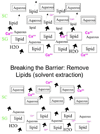Ichthyosis update: towards a function-driven model of pathogenesis of the disorders of cornification and the role of corneocyte proteins in these disorders
- PMID: 18159904
- PMCID: PMC2603607
- DOI: 10.1016/j.yadr.2007.07.011
Ichthyosis update: towards a function-driven model of pathogenesis of the disorders of cornification and the role of corneocyte proteins in these disorders
Abstract
The genetic causes of most of the disorders of cornification have been uncovered. We now face the significant task of delineating how these mutations result in specific phenotypes. Because the permeability barrier resides in the extracellular lipid-enriched domains of the stratum corneum, it was anticipated that disorders of lipid metabolism would perturb the lamellar membrane structures of the extracellular domains and would result in a defective barrier. Unanticipated was the finding that inherited disorders of corneocyte proteins also exhibit, to varying degrees, an impaired permeability barrier. The effect of these corneocyte mutations on barrier function have shed light on how corneocytes interact with the intercellular lamellae to provide the barrier. In some entities, an impaired scaffold leads to fragmented and foreshortened lamellar membranes (e.g., transglutaminase-deficient lamellar ichthyosis, loricrin keratoderma). In others, there is impaired lamellar body secretion (e.g., epidermolytic hyperkeratosis) and altered lipid processing (e.g., Netherton syndrome), leading to deficiency of lamellar membrane structures. The combined insights from delineation of the pathogenesis of lipid metabolic defects and corneocyte protein abnormalities can be used to develop a function-driven model of disease pathogenesis. This model will aid in the development of more targeted approaches to therapy and in understanding some systemic complications of these disorders.
Figures







References
-
- Traupe H. A Guide to Clinical Diagnosis, Genetic Counseling, and Therapy. ed 1. New York: Springer Verlag; 1989. p. 253.
-
- Vahlquist A, Ganemo A, Pigg M, Virtanen M, Westermark P. The clinical spectrum of congenital ichthyosis in Sweden: a review of 127 cases. Acta Derm Venereol Suppl (Stockh) 2003:34–47. - PubMed
-
- Williams ML, Elias PM. From basket weave to barrier. Unifying concepts for the pathogenesis of the disorders of cornification. Arch Dermatol. 1993;129:626–629. - PubMed
-
- Williams ML, Bruckner A, Nopper A. Textbook of Pediatric Dermatology, in Oxford, UK. In: Harper J, Orange A, Prose N, editors. Generalized Disorders of Cornification (the Ichthyoses) Oxford, UK: Blackwell Science; 2006. pp. 1304–1358.
Publication types
MeSH terms
Substances
Grants and funding
LinkOut - more resources
Full Text Sources
Other Literature Sources
Medical
Research Materials
